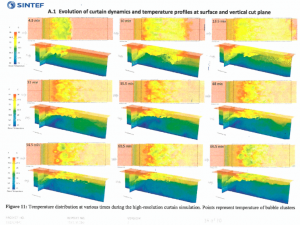Bubble Curtain Technology Receives Virtual Proof of Concept Through SINTEF
The Technology Aims to Decrease the Impact of Devastating Hurricanes and Typhoons Through Temporarily Reducing the Sea Surface Temperature
HORTEN, NORWAY, NORWAY, December 13, 2021 /EINPresswire.com/ -- OceanTherm, a team of scientists from Norway working to decrease the devastation of hurricanes and typhoons with its bubble curtain technology, today announced it has reached Virtual Proof of Concept with its latest research project performed by SINTEF. SINTEF is one of Europe’s largest independent, not-for-profit, research organizations.To test OceanTherm’s bubble curtain technology, a hierarchy of verified and proven models was used to simulate the various scales and physics included in the bubble curtain process. Real data has been used. They were retrieved from the World Ocean Atlas (WOA) provided by NOAA's National Centers for Environmental Information. Also, climatological data and real atmospheric forcing (taken from ECMWF’s ERA5 data set) were used. For the selected use case the bubble curtain system (30 km (19 miles) long bubble curtain at 100 m (330 feet) depth) produced a stable mixed layer with reduced sea surface temperature reduced by 4.9 F (from 84 to 79 F). This is well below the critical cut-off for self-amplification of a hurricane (~ 80 F). After 48 hours, the well-mixed upper layer had reached an area of 30x90 km (19x55 miles), still with a reduced sea surface temperature below 80 F.
The study was implemented to answer OceanTherm’s two questions surrounding its bubble curtain technology:
* Can a bubble curtain create a mixed layer with reduced SST?
*** The study found that the answer is yes.
* When carried off with the ambient current, will the mixed layer remain stable, or will mixing due to ocean processes, atmospheric forcing and solar heating re-heat/erode the mixed layer?
*** The answer is that the mixed layer remained stable after being affected by solar heating and atmospheric forcing. The mixed layer persisted.
The bubble curtain technology has been used for 50 years in Norway to warm up the sea surface temperature in the winter, to avoid fjords from freezing, and now OceanTherm will use the same technology in a different way to make a bigger impact — to lower the sea surface temperature for a short time to prevent devastating natural disasters. Hurricanes are generated when masses of hot and cold air collide above warm ocean water. The hurricanes obtain their energy from the ocean surface when the surface water temperature is above 80 °F, which is why OceanTherm aims to keep the sea surface below this temperature. The bubble curtains work by lifting colder water from an optimal depth, depending on the temperature, and mixing it with the warm surface water, and thereby reducing the sea surface temperature below 80 °F temporarily. Cooling the surface water would deprive the hurricanes of their energy source, potentially reducing the strength before they make landfall, or at least stopping them from developing into stronger hurricanes.
How does one lower the temperature of a large body of water? A “Bubble Curtain” is a perforated pipe lowered in the water. This pipe is placed across a stretch of ocean, such as a narrow straight, and works by supplying bubbles of compressed air to the deep. When the bubbles rise, they bring the cold deep-sea water to the surface, and this cold water cools the warm ocean surface for a short period of time. Strong ocean currents can be considered the engine of the solution. By placing a system in strategic positions, based on research, the colder water will spread out with the help of the currents and influence a larger area, like the coast of Florida. The bubble curtain also only changes the water temperature for a short period of time, thus not resulting in any long-term effects of sea-level temperature changes or the ecosystems that rely on it.
“Honestly, our scientific minds were skeptical. Being skeptical is part of the job description for a scientist while remaining open to new ideas,” says Senior Research Scientist for SINTEF Industry, Department of Process Technology, Flow Technology Group, Paal Skjetne. “Only after testing ideas should they be embraced or discarded. The problem posed by OceanTherm is intriguing and has potentially large ramifications for society. The challenge with addressing the realism of the suggested solution is the cost of doing simple field-scale experiments. Thus, to overcome the immediate problem of costs a virtual proof of concept was pursued. We nested two computer models that have proven themselves in both academic and industrial areas over the last two decades to include the many phenomena inherent in this complex problem. We were surprised by the strong evidence that emerged from the computer simulations supporting the working hypothesis of OceanTherm´s concept. We look forward to continued research into this promising technology in the future.”
OceanTherm is looking for research partners and business partners in the US, to help take the necessary next steps. For more information on how to get involved, please visit www.oceantherm.no and to learn more about its bubble curtain technology, watch the video demo here.
About OceanTherm
Headquartered in Norway, OceanTherm is developing a solution to end devastating natural disasters like hurricanes, tropical storms and typhoons. OceanTherm’s technology lowers the sea surface temperature by lifting colder water from an optimal depth, depending on the temperature, and mixing it with the warm surface water, thereby reducing the sea surface below 80 degrees Fahrenheit inspired by Norweigan infrastructure. For more information, or to learn more about OceanTherm, please visit www.oceantherm.no. You can also follow OceanTherm on their Facebook and LinkedIn accounts.
Mady Dudley
Red Rooster PR
email us here
OceanTherm - Bubble Curtain as Hurricane Prevention
Legal Disclaimer:
EIN Presswire provides this news content "as is" without warranty of any kind. We do not accept any responsibility or liability for the accuracy, content, images, videos, licenses, completeness, legality, or reliability of the information contained in this article. If you have any complaints or copyright issues related to this article, kindly contact the author above.


